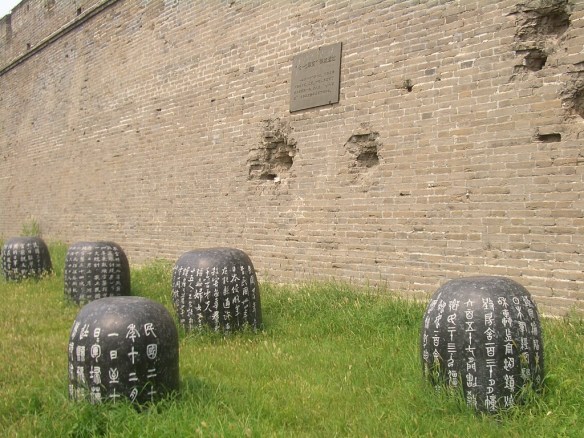
Damage from the Japanese shells on the wall of Wanping Fortress is marked with a memorial plaque now. The text on the stone drums below summarizes the history of the war that followed the incident.
In one of a series of border incidents that marked the mid-1930s, Japanese and Chinese troops clashed at Marco Polo Bridge (Lugouqiao), about ten miles west of Beijing, during the night of 7 July 1937. There was nothing particularly unusual about the circumstances, not even that they led to a series of clashes around Beijing. Neither Nanjing nor Tokyo wanted a large-scale war, in spite of the creation of the Second United Front a few months earlier. But the Chinese were determined not to give up this important railway junction. While Japanese naval officers and diplomats feared that the Kanto- Army’s actions might threaten war with Russia, even the army did not foresee that they would snowball into a full-scale Japanese invasion and the beginning of World War II in Asia (known as the Anti-Japanese Resistance War in China).
How had this happened? At the beginning of July, Chinese troops around the Marco Polo Bridge decided to strengthen their defenses. On 7 July the Japanese conducted night maneuvers around the bridge, firing blank cartridges. The Chinese returned fire briefly, and no one was hurt. A missing Japanese soldier at roll call the next morning, however, prompted the Japanese to begin an attack (though the man returned after twenty minutes).
The Chinese successfully repulsed the Japanese. Over the next few days feints and counter feints on the ground produced inflammatory statements from Tokyo and Nanjing: demands for apologies, complaints about insults, and references to sacred territories. On 17 July, Chiang Kai-shek declared:
China is a weak country, and if, unfortunately, we should reach the limit of our endurance, then there remains only one thing to do, namely, to throw the last ounce of our national energy into a struggle for the independent existence of our nation.… If we allow one more inch of our territory to be lost, then we would be committing an unpardonable offense against our race.
By the end of the month, calculated feints had been replaced by continuous, fierce fighting, and the Beijing–Tianjin corridor had fallen to the Japanese. Japan’s massive invasion of China in the second half of 1937 was not thoroughly planned, but it was the logical result of an unstable situation. What Japan persisted in calling the “China incident” years into the Sino-Japanese War quickly turned into a quagmire. At first, events seemed to be falling Japan’s way. Japan’s best hope was that quick victories might pressure the Nanjing regime into accommodation with Japan. World opinion was sympathetic to China, but China was isolated. Yet the Nationalists would not surrender.
Chiang Kai-shek’s resistance to the Japanese made him a national hero, but after some initial damage inflicted on Japanese attackers, Chinese armies overall were ineffective. Chiang decided to take the war to Shanghai. Perhaps urban fighting would nullify some of Japan’s great advantages in tanks and artillery. It might divert Japanese attention from the northern plains, giving Chinese armies more time to build up defenses. And it might even involve the Western powers as they witnessed Japan’s invasion from the concessions. However, for all the bravery of their defense of Shanghai, the Nationalists lost many of their best troops while Japan took the north anyway. Chiang Kai-shek’s attempt to slow down the Japanese by bombing the dikes on the Yellow River failed, leaving 800,000 Chinese dead in 1938. And it was Chinese bombers, missing the Japanese fleet, that hit Shanghai instead. The defense of the city persisted through October, resulting in 250,000 Chinese military casualties (almost 60 percent of Chiang’s troops) and 40,000 Japanese. Much of the fighting was hand-to-hand, and one foreign account noted: “No quarter was given and no dead were buried. Flyblown corpses lay in the August sun until the smells of death and burning were wafted over Soochow Creek into the Western area.”
Finally, Japanese troops, supplemented by armies landed at Hangzhou Bay, broke though Chinese lines and pursued their enemy up the Yangzi River to Nanjing. After swearing to defend his capital to the last, Chiang entrusted its defense to a former warlord who soon fled. Nanjing was then subjected to seven weeks of terror by the Japanese. Standard accounts, based on the contemporary observations of foreign observers, estimate that 200,000 Chinese civilians were murdered (not killed in battle but bayoneted, buried alive, or burned with kerosene) and 20,000 women raped. Whatever the exact numbers, the “Nanjing massacre” – still a controversial issue in Sino-Japanese relations today – represented a breakdown of Japanese military discipline. Perhaps the brutalization, anger, and anxiety of ordinary Japanese soldiers, who had faced far tougher Chinese resistance than they had been led to expect, combined with the vagueness of the goals of this still-undeclared war to produce a sense that all Chinese were the enemy and should be made to pay.